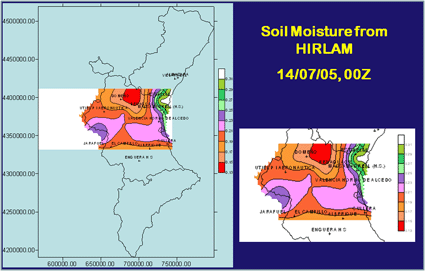[<][<=][=>]Index of this webpage
**++Climatology from Satellites Group++**
**++Postgraduate++**
++Current Research Assistants (and Doctorate Students):++
++Doctorate on Remote Sensing Students:++
++Master Postgraduate:++
++Master Students:++
++Advanced Undergraduate:++
++Practicum - Practical Training:++
++Current External:++
++Past ..., but very close to us ...:++
**++Publications++**
**++Links to Significant Meetings++**
''**++2015++**''
''**++2014++**''
**++Active Collaborations++**
**++Acknowledgments**++
**++Book suggestions++**
**++Link of the Day++** (in reality, ... every now and then)
2013
December
**++Teaching Subjects++**
Postgraduate Course on ''New Observation and Watching Systems in Meteorology and Climatology''
**Some Teaching Publications**
**++Research Lines++**
**''I Validation of low spatial resolution remote sensing data and products (GERB, SMOS, EPS/MetOp, SMAP)''**
**''II Radiative balance studies (GERB, CERES, SEVIRI, EarthCARE)''**
**''III Soil moisture from passive microwaves (SMOS)''**
**++Valencia & Alacant Anchor Stations++**
**What is an ''ANCHOR STATION''**? (from Professor H.-J. Bolle)/
**Rationale**/
**Desirable measurements at ''Anchor Stations''**/
How Representative are the ''Alacant and the Valencia Anchor Stations'' Measurements of their Respective Surrounding Meteorology?
Proposal for a ''Water Cycle Observatory'': The VALENCIA and the ALACANT ANCHOR STATIONS, Meteorological Reference Stations for Remote Sensing Data and Products
**Publications**
2008
2007
2006
2005
2003
2002
**++Involvement in Satellite Earth Observation Missions++**
**SMOS (''Soil Moisture and Ocean Salinity'')**/
**SMOS Validation Rehearsal Campaign Activities at the Valencia Anchor Station**
**Scientific Team**
**Purpose**
**Activities
**SM Measurements**
**Vegetation Measurements**
**Soil texture**
**Airborne Operations during the SMOS Validation Rehearsal Campaign (Tauriainen, 2008)**
**Modelling**
**Publications**
2011
2010
2008
2007
2006
2005
2004
2003
2002
**Projects**
**EarthCARE (''Earth Clouds, Aerosols and Radiation Explorer'')**
**Publications**
2012
2011
2007
2006
2004
2003
2002
2001
**Projects**
**GERB (''Geostationary Earth Radiation Budget'')**/
**Publications**
2011
2008
2007
2006
2005
2004
2000
**Projects**
**CERES (''Clouds and the Earth's Radiant Energy System'')**/
**Publications**
2012
2008
2007
2006
2005
2004
2000
**Projects**
**EPS/MetOp (''EUMETSAT Polar System / MetOp'')**/
**Publications**
**Projects**
**++Other Significant Research Projects and Contracts++**
**Publications**
**++Field Campaigns++**
**++Supervision of Research Academic Work++**
**++Selected Significant Publications++**
**++Photographic Album: A Sample++**/
2014
2013
2012
2008
2007
2006
2005
2004
2003
2002
2001
2000
1988
[<][<=][=>][*]
**SMOS Validation Rehearsal Campaign Activities at the Valencia Anchor Station**
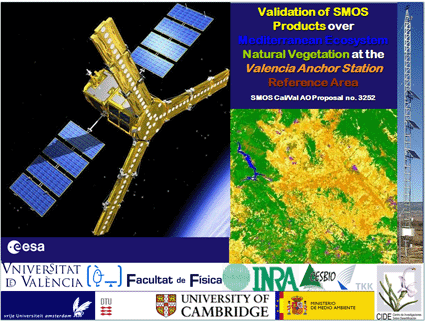
Within the TV programme Medi Ambient of the Valencia Radio Television Network this Campaign was magnificently shown as The Eyes of Science on 11th and 13th December, 2008.
Medi Ambient is a TV programme specialized on information on environmental matters in the Valencia Autonomous Community.
Successful dress rehearsal for SMOS validation As ESA looks forward to the launch of its SMOS Earth Explorer next year, the extensive SMOS Validation Rehearsal Campaign took place over Germany, Spain and the Mediterranean Sea during last April, 2008. The campaign rehearsed the complex procedures involved in validating the mission's data ï¿˝ data crucial for a better understanding of the Earth's water cycle.
More than 100 people in total, scientists and students from the University of Valencia, Spain, took soil-moisture gravimetric samples and probe readings from the SMOS control area of the Valencia Anchor Station, covering an area of 100 km2 and including different types of vegetation. The measuring activities from the aircraft and on the ground were carried out following periods of a significant rainfall event so that the so-called drying period of the soil could be nicely represented in the data.
Scientific Team
PI of the Valencia Anchor Station Site (Spain): Ernesto Lopez-Baeza(1,2)
Team: R. Acosta(1,3), M.C. Antolin(2), F. Belda(4), A. Cano(1), E. Carbo(2), A. Fidalgo(5), S. Juglea(6), Y. Kerr(6), B. Martinez(7,8), C. Millan-Scheiding(1,2), D. Rodriguez(1), K. Saleh(9), J. Sanchis(1), J.-P. Wigneron(10)
Other Contributors: J.E. Balling(11), C. Domenech(1), EOLAB(8), A.G. Ferreira(1,12), J. Ferrer(5), J. Grant(13), J.Marco(2) C. Narbon(1), B. Navascues(14), E. Rodriguez-Camino(14), N. Skou(10), S. Sï¿˝bjï¿˝rg(10), P. Soriano(2), J. Tamayo(4), S. Tauriainen(15), E. Torre(2), G. Torregrosa(2), A. Velazquez Blazquez(1), S. Vidal(1)
European Space Scientific Officers (ESA) Scientific Officers: C. Bouzinac, S. Delwart, P. Wursteisen
(1) University of Valencia (UVEG), Dept. of Physics of the Earth and Thermodynamics. Climatology from Satellites Group, Valencia, (GCS), Spain
(2) Center for Desertification Research (CIDE). Dept of Territorial Planning, Valencia, Spain
(3) Universidade de Sï¿˝o Paulo. Laboratorio de Clima e Biosfera, Sao Paulo, Brazil
(4) Meteorological State Agency (AEMet), Meteorological Regional Center of Valencia, Valencia, Spain
(5) Jucar River Basin Authority, (CHJ, Confederaciï¿˝n Hidrogrï¿˝fica del Jucar), Valencia, Spain
(6) Centre d'Etudes Spatiales de la BIOsphï¿˝re (CESBIO), Toulouse, France
(7) UVEG, Dept. of Physics of the Earth and Thermodynamics. Remote Sensing Unit, Valencia, Spain
(8) EOLAB-Spain, S.L., Valencia, Spain
(9) University of Cambridge, Department of Geography, Cambridge, United Kingdom
(10) INRA Bordeaux-Aquitaine, Ecologie fonctionnelle et PHYSique de l'Environnement (EPHYSE), Bordeaux, France
(11) Technical University of Denmark (TUD), Lyngby, Denmark
(12) Fundaï¿˝ï¿˝o Cearense de Meteorologia e Recursos Hï¿˝dricos (FUNCEME), Fortaleza, Brazil
(13) Vrije Universiteit Amsterdam, Amsterdam, The Netherlands
(14) Meteorological State Agency (AEMet), Madrid, Spain
(15) Helsinki University of Technology (HUT) or Teknillinen Korkeakoulu (TKK), Laboratory of Space Technology, Helsinki, Finland
Purpose
The general purpose of the SMOS Validation Rehearsal Campaign is to repeat the Commissioning Phase execution with all centres, all tools, all participants, all structures, all data available, assuming all tools and structures are ready and trying to produce as close as possible the post-launch conditions. The aim is to test the readiness, the ensemble coordination and the speed of operations, and to avoid as far as possible any unexpected deficiencies of the plan and procedure during the real Commissioning Phase campaigns (Bouzinac et al., 2008). A specific added-value objective of the Valencia Anchor Station Team is to validate the ground sampling strategy defined for this campaign (10 x 10 km2) by comparing the ground area-estimated products with the aircraft area-integrated measurements in order to be able to extend the methodology to the larger SMOS footprint representative area (125 x 125 km2). The scientific framework in which context these objectives will be studied is monitoring of soil drying after a significant rainfall event takes place in the study area.
(Bouzinac, C., S. Delwart and P. Wursteisen + members of the validation teams (2008): SMOS Validation Rehearsal Campaign Plan. ESA-ESTEC)
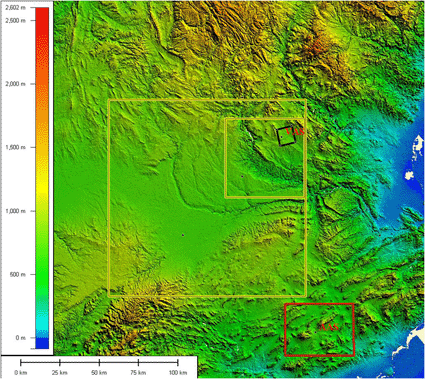
Coordinates of the different validations zones defined:
VAS:
(39ï¿˝34ï¿˝15ï¿˝ï¿˝N, 1ï¿˝17ï¿˝18ï¿˝ï¿˝W, 813 m)
For 10x10 km2:
UTM (ED50) coordinates:
NW: 643966 4386507
NE: 653735 4388886
SE: 655995 4378531
SW: 646226 4376152
or
NW corner: 39ï¿˝36ï¿˝51.83ï¿˝ - 001ï¿˝19ï¿˝26.57ï¿˝
SW corner: 39ï¿˝31ï¿˝14.71ï¿˝ - 001ï¿˝18ï¿˝00.04ï¿˝
NE corner: 39ï¿˝38ï¿˝02.85ï¿˝ - 001ï¿˝12ï¿˝35.08ï¿˝
SE corner: 39ï¿˝32ï¿˝25.66ï¿˝ - 001ï¿˝11ï¿˝09.08ï¿˝
For 50x50 km2:
NW -> 1.698423W 39.683639N
NE -> 1.115635W 39.675642N
SE -> 1.127737W 39.225365N
SW -> 1.706786W 39.233235N
For 125x125 km2:
NW -> 2.563715W 39.799068N
NE -> 1.104126 39.784399N
SE -> 1.134179W 38.658662N
SW -> 2.570636W 38.672758N
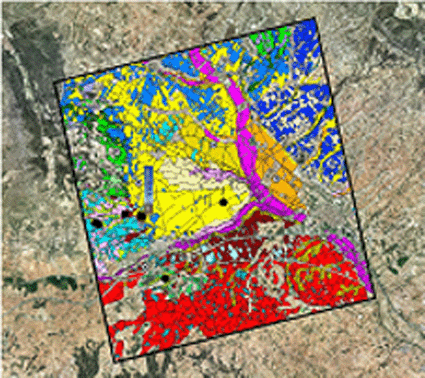
Physio-hydrological Units defined in the 10 x 10 km2 area attending to criteria of lithology, geology, climate, soil type, slope, topography, physiography, and vegetation cover (see picture below). An automated wireless network of SM sensors (Theta Probe) has been designed and is currently under development and being implemented over the most significant physio-hydrological units
SM network ■ VAS ï¿˝ SM stations (operative) o SM stations (tbc)
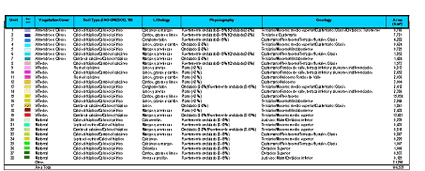
Definition and characteristics of the physio-hydrological units defined
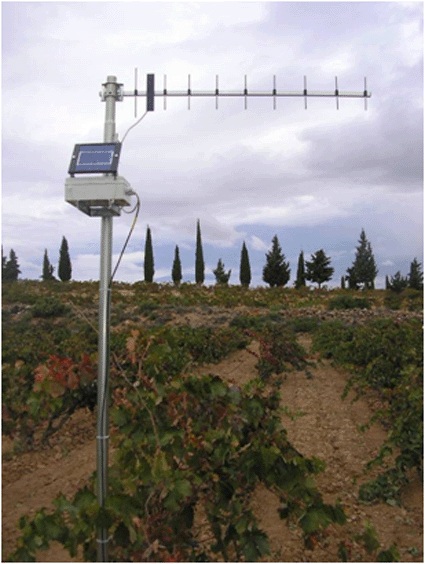
Example of wireless SM station
Activities
Ground Measurements during aircraft operations
Objectives:
(i) To measure soil moisture content for the whole 10 x 10 km2 under saturation conditions, i. e., after a significant rain event, and during the soil drying period, i.e., 24, 48 h, 5-7 days, 10-15 days, after precipitation
(ii) To measure SM of each significant and representative hydro-physiological unit:
ï¿˝ Compare different SM measurements within each unit
ï¿˝ Compare different SM measurements in polygones within each
ï¿˝ Compare SM measurements of similar units
ï¿˝ Compare SM measurements of different units
(iii) Establish relationships to unify / fragment units or re-assign polygons in different units
(iv) Provide the approximate average for each unit and for all the units in total within the 10 x 10 km2
(v) Compare SM from the units to that of the total area
(vi) Study the representativity of the automatic SM stations in the whole 10 x 10 km2 area, using the large number of measurements for eachy day of the campaign
(vii) Establish a quick and efficacious methodology to estï¿˝mate SM of a large area out of a few measurements, as preparation for Cal/Val
(viii) Compare SM under humid and dry conditions; establish the spatial and temporal dynamics of SM
The campaign at the Valencia Anchor Station Site will begin on 19th April. The first possible campaign flight should be performed before sunrise on 20th April, independently of weather conditions, except if it is actually raining.
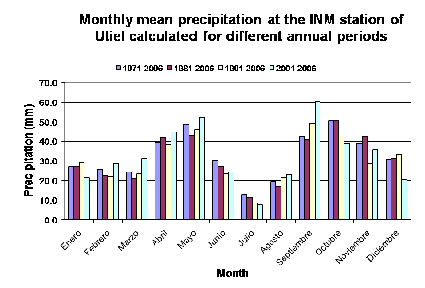
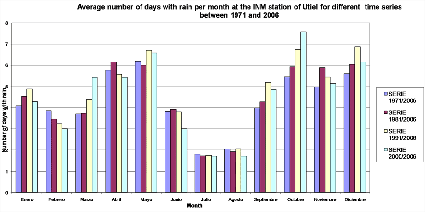
The area will be crossed diagonally (SE to NW) and along 5 separate North/Southbound parallel lines displaced by 2 km relative to each other.
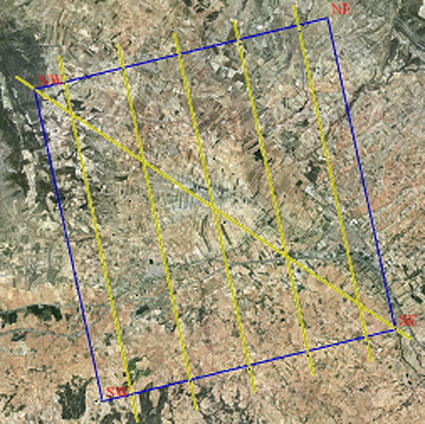
Valencia Anchor Station study area with the five flight lines and the diagonal flight line all geo-referenced over an orthophoto of the study area
SM Measurements
Volumetric/Gravimetric soil samples Volumetric probe measurements (Theta Probe)
In each sampling plot, volumetric SM data will be obtained by means of capacitance probes (Delta-T Theta probes) calibrated according to the soil textures obtained in each case and, in parallel, soil samples will be obtained in cylinders of known volumen where volumetric soil moisture will be measured, thus obtaining soil bulk density. From that, soil porosity will be estimated because this parameter is responsible of the soil water retention capacity.
The percent of water in volume obtained will be used as ï¿˝ground truthï¿˝ with respect to the SM values obtained with the capacitance probes.
The ground measurements will consist of 20 teams distributed throughout the entire area, (4 teams for the detailed diagonal flight, 4 teams for the harder soil shrub area (left-hand side of the image, teams 5, 6, 7, 8), and 3 teams for the rest of each flight line remaining. Depending on the soil properties and hardiness each group will take a large number of cylinder volumetric samples and an average of 1000 volumetric probe measurements every flight day.
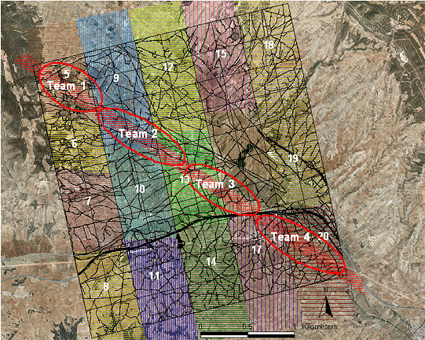
Flight lines over the 10 x 10 km2 area
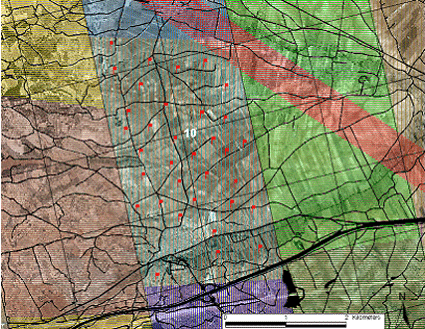
Detail of the sampling to be carried out by one of the teams (team #10, just an example)
One team more will perform sea surface measurements, for calibration purposes of the radiometers onboard the research aircraft, and according to the Spanish Port System (Puertos del Estado)(tbc)
Vegetation Measurements
From our detailed vegetation map (generated at 1:2000 scale), vegetation over the 10 x 10 km2 area shows a scarce diversity of vegetation species. Within the area, the major vegetation uses are vineyard, almond- and olive-trees, coniferous forests, matorral shrubs (Thymus vulgaris, Rosmarinus officinalis, Quercus coccifera, Genista scorpius, Ulex parviflorus, Ramnus licioides, Stipa tenacissima, Juniperus communis), and very very scarce areas of cereals (Zea mays and Avena sativa).
Vegetation parameter sampling is not needed to be too intensive. However, accurate estimation of vegetation stage should be achieved through simple measurements over well chosen areas:
ï¿˝ Vegetation height
ï¿˝ Phenologic stage (number of leaves in vineyards/plant, etc) in some fields
ï¿˝ Digital photographs giving general information on the phenology (in orchards)
ï¿˝ LAI measurements in shrubs and matorral areas
ï¿˝ Alometric parameter sampling in tree areas to relate plant dimensions to vegetation characteristics which are required as inputs for the retrieval models
ï¿˝ Vegetation water content sampling
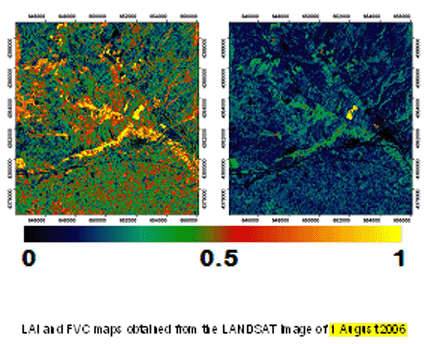
LAI and FVC maps over the area (August 2006, courtesy of EOLAB)
For each of the dominant vegetation types, the sampling to be performed will consist of: branches and leaves of almond, olive, Holm Oak and pine trees, and complete individuals of shrubs. In these samples we will measure all the dimensional parameters and laboratory analysis to estimate biomass.
Soil texture
Soil samples on measured plots will be taken before the campaign to begin laboratory analysis and probe texture calibrations. Each team will measure a statistically significant amount of point measurements in plots distributed throughout the selected area. Of these plots, soil bulk density, percentage of organic material, texture and probe calibration analysis will be determined.
Airborne Operations during the SMOS Validation Rehearsal Campaign (Tauriainen, 2008)
The flight measurements will be performed using the TKK Short Skyvan research aircraft. The payload for the SMOS Validation Rehearsal campaign will consist of the following instruments:
ï¿˝ L-band radiometer EMIRAD provided by the Technical University of Denmark (TUD)
ï¿˝ HUT-2D L-band imaging interferometric radiometer provided by TKK
ï¿˝ PARIS GPS reflectrometry system provided by IEEC
ï¿˝ IR sensor provided by the Finnish Institute of Maritime Research (FIMR)
ï¿˝ a low resolution digital video camera
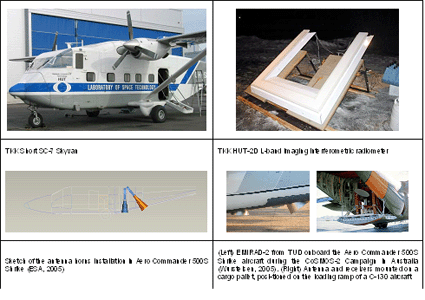
Skyvan and its payload
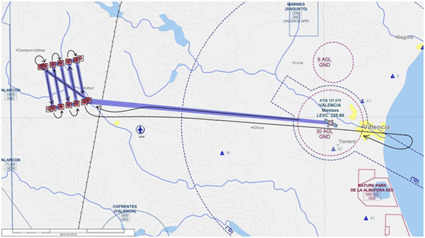
Skyvan transit from Valencia Airport to the Valencia Anchor Station site and operations
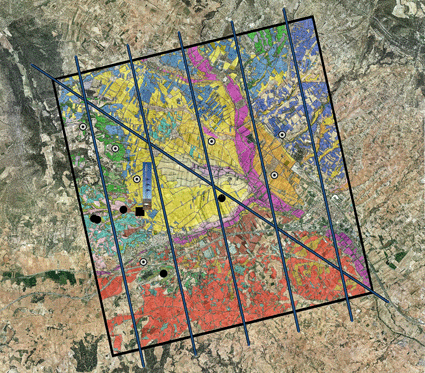
Flight lines over the study area including operational and forthcoming stations:
■ VAS
ï¿˝ SM stations (operative)
o SM stations (to be deployed)/
Flight measurements over the VAS site should be followed by sea water measurements for instrument calibration. Therefore the flight should be extended before landing at the Valencia airport to cover a short track over the Mediterranean. The Valencia buoy from the Spanish Port System (Puertos del Estado) could be of interest (tbc)
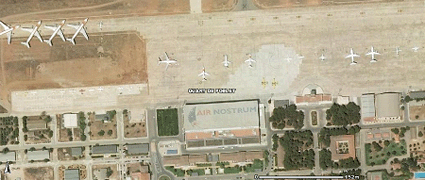
The Skyvan will be kept at the
Air Nostrum facilities
in the Valencia Manises Airport (see Google location)
Modelling
(i) At CESBIO, modelling work is currently carried out to simulate passive microwave brightness temperatures. Surfex, a SVAT (Soil-Vegetation-Atmosphere Transfer) model from Mï¿˝tï¿˝o France, is used to characterize the surface according to ground and meteorological data from the Valencia Anchor Station area. Outputs from this surface modelling are used in the L-MEB (L-band Microwave Emission of the Biosphere, Wigneron et al., 2007) model to simulate the surface emission (brightness temperatures) at L-band. These simulations, spatialized at the SMOS pixel, will be compared in a further step with the SMOS measurements during the Commissioning Phase.
(Wigneron J-P, Y. Kerr, P. Waldteufel, K. Saleh, M.-J. Escorihuela, P., Richaume, P. Ferrazzoli, P. de Rosnay, R. Gurney, J.-C. Calvet, J.P., Grant, M. Guglielmetti, B. Hornbuckle, C. Mï¿˝tzler, T. Pellarin, M. Schwank (2007): L-band Microwave Emission of the Biosphere (L-MEB) Model: Description and calibration against experimental data sets over crop fields. Remote Sens. Env., 107, p. 639-655, 2007)
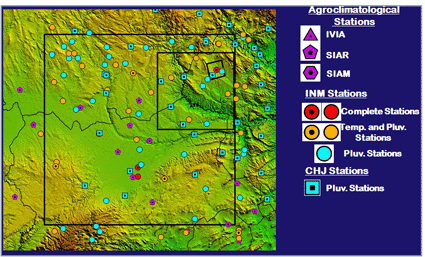
Meteorological stations available for modelling and spatializing at the SMOS footprint scale
(ii) HIRLAM is currently being applied to the area. Soil Moisture fields will be extracted from HIRLAM analyses during the SMOS Validation Rehearsal Campaign and compared to the Soil Moisture network, in collaboration with the Spanish AEMet. As a trial, the picture below shows the Soil Moisture field obtained from the output from HIRLAM for 14/07/05, at 00Z. All the HIRLAM analyses will be available for the SMOS Validation Rehearsal Campaign.
